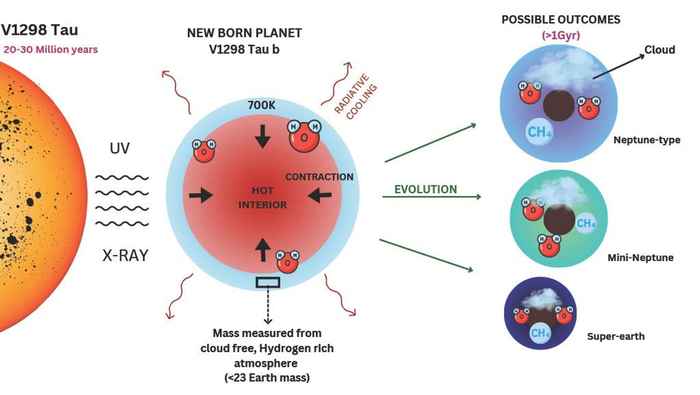Witnessing the early evolution of young stellar systems
27 May 2024

In the last decade, the field of exoplanets has witnessed a remarkable growth, propelled by missions like Kepler and TESS. As a result, we now know of approximately 5500 exoplanets. Further, statistical analysis of this exoplanet population has unveiled a category of planets termed super-Earths and sub-Neptunes, falling in size between Earth and Neptune as the most common outcome of planet formation.
Youngest known exoplanet
These super-Earths and sub-Neptunes have become the focus of extensive investigation that aims to unravel their composition, internal structure and origins. Yet, crucial aspects of these planets’ earliest lives remain unknown: where they originate and how they evolve over time. In an effort to address these fundamental questions, a team of astronomers observed the atmosphere of a very young exoplanet, named V1298 Tau b, using the Hubble Space Telescope. V1298 Tau b is only 20-30 million years old. That makes it one of the youngest known exoplanets, and an ideal candidate for unravelling the secrets of planetary evolution.
Unusual atmosphere
In their paper that’s out now in Nature Astronomy, main researchers Jean-Michel Desert and his PhD student Saugata Barat (both from the University of Amsterdam) reveal the somewhat surprising results of the first transmission spectrum analysis of the atmosphere of such a young planet. Their findings reveal a clear and extended atmosphere spanning approximately 1000 kilometres, mostly composed of primordial hydrogen and helium, with traces of water vapor. This composition and structure is notably different from the types of atmospheres found in solar system bodies like that of Titan. Titan’s atmosphere only spans approximately 50 kilometres and is dominated by heavier elements such as carbon and oxygen. V1298 Tau b’s atmospheric composition is also significantly different from the planet’s more mature counterparts, by a factor of 100.
Metal-poor
Moreover, leveraging water vapor absorption features, the authors determined the planet's heavy element abundance, finding it significantly lower ("metal-poor" in astronomical terms) compared to mature counterparts by a factor of 100. This study represents a critical comparison between the atmospheric spectrum of a young sub-Neptune/super-Earth and its mature counterparts, highlighting fundamental disparities in their nature, chemistry, and composition.
A hotter planet interior than anticipated
The results are interesting not only because of what it finds, but also because what it does not find. At the temperature of this planet, the atmosphere is expected to be rich in methane. However, the current study does not find methane. A potential explanation could be that the planet is has a very hot interior, which coupled with strong vertical mixing removes the methane from the observable upper atmosphere. By comparing the observations with theoretical models, it allows the authors to derive a lower limit on the interior temperature (>300 Kelvin), which is found to be much hotter than the what theoretical is expectation for such a planeted for mature sub-Neptunes and super-Earths. V1298 Tau b is likely to becurrently undergoing a phase of thermal cooling and contraction.
The planet’s mass points towards a progenitor of a super-earth
Past studies using the standard radial velocity technique had reported a Saturn-like mass for V1298 Tau b. This study proposed a rapid contraction to explain the mass and radius at such a young age.
The current study refined the planet's mass estimate using an innovative method: by directly analyzing the observed transmission spectrum, rather than using standard techniques like radial velocities. This result rules out previous mass estimates of this planet using radial velocities, and alleviates the requirement of rapid contraction phase, previously proposed.
The findings of this paper solidify V1298 Tau b's classification as a progenitor of sub-Neptunes/super-Earths. This approach opens avenues for characterizing the masses of young transiting exoplanets, overcoming challenges posed by host star activity.
Interpreting these findings as evidence of ongoing early evolution, the team anticipates V1298 Tau b's atmosphere to transform from an extended, puffy, metal-poor envelope to a thinner, heavier atmosphere akin to mature sub-Neptunes and super-Earths.
Next steps
Building upon this research, endeavours are underway to delve deeper into the atmospheres of young transiting planets. The authors have turned to the James Webb Space Telescope, offering enhanced wavelength coverage and precision compared to HST, to further unravel the mysteries of this unique young world.
Publication details
Saugata Barat, Jean-Michel Déesert et al, The metal-poor atmosphere of a potential sub-Neptune progenitor, in: Nature Astronomy, 9 May 2024. DOI: https://doi.org/10.1038/s41550-024-02257-0